Natural Disaster Information System (NDIS) for RPAS Mission Planning
Highlights
- A lightweight, modular information system was developed to support RPAS (drone) mission planning for geohazard contexts.
- The framework integrates hazard type, hazard stage, and sensor–drone compatibility using a structured, rule-based approach.
- NDIS enables rapid and informed decision-making and planning of drone missions for hazard monitoring and disaster response.
- The system can be adapted across different disaster types and operational needs to support mitigation strategies globally.
Abstract
1. Introduction
2. Data and Methods
2.1. Geohazard Dataset and Engineering
2.1.1. Volcanoes
2.1.2. Landslides
2.1.3. Tsunamis
2.1.4. Active Faults
2.1.5. Earthquakes
2.1.6. Nuclear Power Plants
2.1.7. Supporting Geospatial Layers and Preprocessing
2.1.8. RPAS Database Compilation and Classification
2.1.9. Geophysical and Remote Sensing Sensors
2.2. Methods
3. Results
3.1. System Implementation and Deployment
3.1.1. Deployment Procedure
3.1.2. System Integration
3.2. Web Application Capabilities
3.3. Distribution of Recommended Drone Models and Sensor Utilization Across Hazards
4. Discussion
4.1. Interpretation of Drone-Sensor Assignment Patterns
4.2. Advantages of the NDIS Framework
4.3. Limitations and Trade-Offs
4.4. Operational Implications
4.5. Future Work
- Uncertainty modeling: The current rule-based system operates under deterministic assumptions. Incorporating probabilistic elements—such as wind variability, sensor reliability, or communication loss—could support the generation of robustness indicators or confidence levels for each mission recommendation.
- Flight path trajectory visualization: Present outputs include estimated distance and duration; however, visualizing projected flight paths could improve operational planning. Such features would support airspace coordination, obstacle avoidance, and endurance validation, especially in mission operations with terrain constraints.
- Workflow continuity: As NDIS operates within the Esri environment, future development could explore integration with ArcGIS Flight or equivalent modules. This would enable direct transfer of recommended flight parameters into established mission planning tools, facilitating smoother transitions from decision support to field implementation.
- Integration with real-time data feeds: The current system uses static input layers. Future versions may incorporate live feeds through standard-compliant interfaces such as Web Feature Services (WFS). For example, volcano monitoring data from the Smithsonian Global Volcanism Program (GVP) is accessible via OGC-compatible endpoints (GeoJSON, CSV, Shapefile). Extending this capability to other sources, such as the ISC Bulletin or national warning systems, would support more timely and adaptive mission planning.
5. Conclusions
Author Contributions
Funding
Data Availability Statement
Acknowledgments
Conflicts of Interest
Abbreviations
| AGOL | ArcGIS Online |
| API | Application Programming Interface |
| CI/CD | Continuous Integration/Continuous Deployment |
| CPM | Critical Path Method |
| CSV | Comma-Separated Values |
| DT | Decision Tree |
| EM | Electromagnetic |
| ExB | Experience Builder (from ArcGIS Experience Builder) |
| GIS | Geographic Information System |
| GPR | Ground Penetrating Radar |
| GVP | Global Volcanism Program |
| HTML | HyperText Markup Language |
| ISC | International Seismological Centre |
| JSON | JavaScript Object Notation |
| LiDAR | Light Detection and Ranging |
| MCDA | Multi-Criteria Decision Analysis |
| NDIS | Natural Disaster Information System |
| OGC | Open Geospatial Consortium |
| RF | Random Forest |
| RPAS | Remotely Piloted Aircraft Systems |
| SaaS | Software-as-a-Service |
| SAR | Synthetic Aperture Radar |
| SAR | Search and Rescue |
| SDSS | Spatial Decision Support System |
| SMOTE | Synthetic Minority Oversampling Technique |
| UAV | Unmanned Aerial Vehicle |
| VEI | Volcano Explosivity Index |
| VTOL | Vertical Takeoff and Landing |
| WFS | Web Feature Service |
Appendix A. Geohazard Dataset and Engineering Supplementary Material
Appendix A.1. Volcanoes
- Intensity: A weighted assignment of Volcanic Explosivity Index (VEI) was applied using a random distribution favoring lower VEIs to reflect natural eruption frequency patterns. The intensity category (Table A1) was derived from the Volcanic Explosivity Index (VEI) using a simplified classification scheme, loosely based on the original VEI scale proposed by Newhall and Self [62].
| VEI Range | NDIS Ordinal Intensity | Label |
|---|---|---|
| 0–1 | 1 | Very Low |
| 2 | 2 | Low |
| 3–4 | 3 | Moderate |
| 5–6 | 4 | High |
| 7–8 | 5 | Extreme |
- Duration: Eruption duration was derived from the start and end date fields when available. While source data varied in temporal scale (e.g., minutes, days, or longer), all durations were standardized to minutes. For incomplete records, fallback durations were assigned using VEI-based ranges, reflecting observed correlations between eruption magnitude and temporal extent [62,63]. This estimation supports applications in mission scheduling and prioritization, where longer-duration events may indicate persistent hazards requiring extended monitoring. For each volcano, the longest recorded eruption was retained to represent maximum hazard persistence.
- Economic Loss: Direct damage estimates were derived from a supplementary dataset containing both numeric and descriptive damage records. Where available, direct estimates from DAMAGE_MILLIONS_DOLLARS_TOTAL were used. For entries with missing financial values, qualitative descriptors (e.g., “Limited”, “Severe”) were converted into approximate monetary ranges following established disaster categorization approaches [24,64]. Remaining gaps were then estimated using intensity-based probabilistic methods, under the assumption that more intense events tend to incur greater losses [65], a common assumption in disaster impact literature.
Appendix A.2. Tsunami Ordinal Table
| NDIS Ordinal Intensity | TS_MT_II/TS_INTENSITY Range | h (m) |
|---|---|---|
| 1 | <1.0 | h < 1.41 |
| 2 | 1.0–2.99 | 1.41 ≤ h < 5.66 |
| 3 | 3.0–4.49 | 5.66 ≤ h < 22.63 |
| 4 | 4.5–5.99 | 22.63 ≤ h < 64.00 |
| 5 | ≥ 6.0 | h ≥ 64.00 |
Appendix A.3. Notation Key Parameters for Table 1
- hazard distance
- predefined/user defined survey parameters (length, width, line spacing)
- (average cruising speed)
- mapping speed:
- -
- Camera, LiDAR, Hyperspectral, Multispectral, EM, Gravimeter, Gamma: 5 m/s
- -
- GPR, Thermal: 3 m/s
- -
- Magnetometer: 10 m/s
- 3 min
Appendix A.4. Notation Key Parameters for Table 2
- : Intensity (ordinal scale, 1–5)
- : Duration in minutes
- : Simulated economic loss in millions USD
- : Uniform random sampling between a and b
- : Estimated population within buffer (30 km)
- : Minimum and maximum economic loss values for a given intensity class
- : Landslide size index (normalized)
- : Casualty index = fatalities + 0.5 × injuries
- : Tsunami wave height in meters at the shoreline [19].
- : Earthquake magnitude
- : Earthquake depth (km)
- : Fault parameters: average dip, net slip rate, vertical separation rate
- : Nuclear power plant capacity in megawatts
- : Mapping function to intensity (e.g., binning, scaling)
Appendix B. Additional Figures for Web Application Capabilities
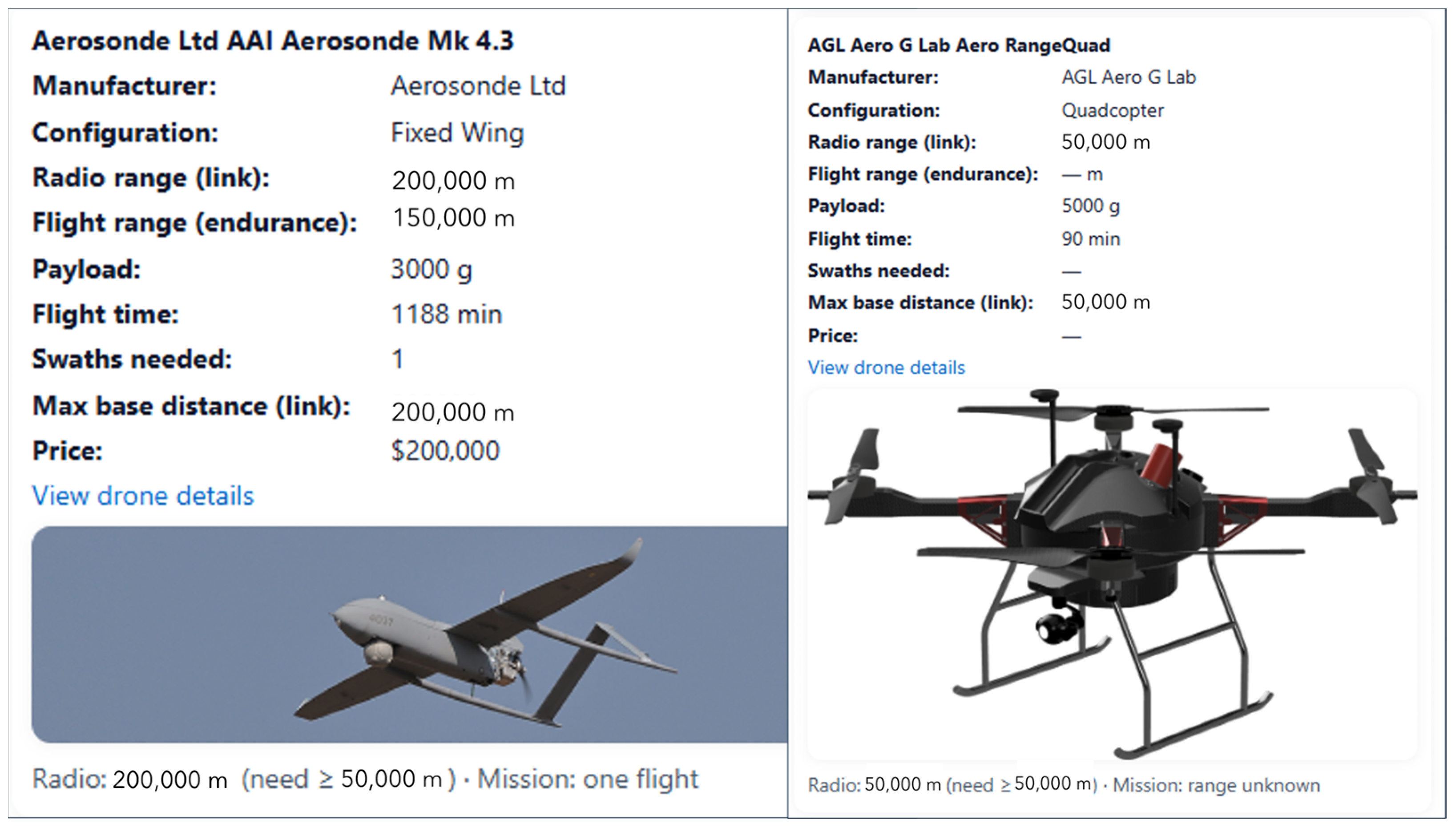
Appendix C. System Performance and Hosting Configuration
- Processor: Intel(R) Core(TM) i3-5005U CPU @ 2.00 GHz
- RAM: 16.0 GB
- Storage: 466 GB SSD (HP SSD S700 500 GB)
- Graphics: NVIDIA GeForce 920M (2 GB) + Intel(R) HD Graphics 5500
- System Type: 64-bit operating system, x64-based processor
- vCPU: 1 Core
- RAM: 1.75 GB
- Storage: 10 GB
- Performance Tier: Basic B1
- Hosting Runtime: Python 3.10.16, deployed via Kudu-Lite
References
- Tepylo, N.; Debelle, L.; Laliberte, J. Public Perception of Remotely Piloted Aircraft Systems in Canada. Technol. Soc. 2023, 73, 102242. [Google Scholar] [CrossRef]
- Manfreda, S.; McCabe, M.F.; Miller, P.E.; Lucas, R.; Pajuelo Madrigal, V.; Mallinis, G.; Ben Dor, E.; Helman, D.; Estes, L.; Ciraolo, G.; et al. On the Use of Unmanned Aerial Systems for Environmental Monitoring. Remote Sens. 2018, 10, 641. [Google Scholar] [CrossRef]
- Li, T.; Wang, C.; Meng, M.Q.-H.; de Silva, C.W. Coverage Sampling Planner for UAV-Enabled Environmental Exploration and Field Mapping. In Proceedings of the 2019 IEEE/RSJ International Conference on Intelligent Robots and Systems (IROS), Macau, China, 4–8 November 2019. [Google Scholar]
- Gómez-López, J.M.; Pérez-García, J.L.; Mozas-Calvache, A.T.; Delgado-García, J. Mission Flight Planning of RPAS for Photogrammetric Studies in Complex Scenes. ISPRS Int. J. Geo-Inf. 2020, 9, 392. [Google Scholar] [CrossRef]
- Quamar, M.M.; Al-Ramadan, B.; Khan, K.; Shafiullah, M.; El Ferik, S. Advancements and Applications of Drone-Integrated Geographic Information System Technology—A Review. Remote Sens. 2023, 15, 5039. [Google Scholar] [CrossRef]
- Dinitz, L.; Forney, W.; Byrd, K. Decision-Support Systems for Natural-Hazards and Land-Management Issues; U.S. Geological Survey: Reston, VA, USA, 2012. [Google Scholar]
- Newman, J.P.; Maier, H.R.; Riddell, G.A.; Zecchin, A.C.; Daniell, J.E.; Schaefer, A.M.; van Delden, H.; Khazai, B.; O’Flaherty, M.J.; Newland, C.P. Review of Literature on Decision Support Systems for Natural Hazard Risk Reduction: Current Status and Future Research Directions. Environ. Model. Softw. 2017, 96, 378–409. [Google Scholar] [CrossRef]
- Elkady, S.; Hernantes, J.; Labaka, L. Decision-Making for Community Resilience: A Review of Decision Support Systems and Their Applications. Heliyon 2024, 10, e33116. [Google Scholar] [CrossRef] [PubMed]
- Donezar-Hoyos, U.; Albizua-Huarte, L.; Amezketa-Lizarraga, E.; Barinagarrementeria-Arrese, I.; Ciriza, R.; De Blas-Corral, T.; Larrañaga-Urien, A.; Ros-Elso, F.; Tamés-Noriega, A.; Viñuales-Lasheras, M.; et al. The Copernicus EMS Validation Service as a Vector for Improving the Emergency Mapping Based on Sentinel Data. Rev. Teledetec. 2020, 56, 23–34. [Google Scholar] [CrossRef]
- Montoya-Montes, I.; Quental, L.; Galindo, I.; Holohan, E.P.; Jaud, M.; Parker, K.; Rodrigues, D.; Gonçalves, P.; Sánchez, N.; García, I.; et al. Copernicus Services and Geohazards Management. Lessons Learnt from Citizens’ Observatories. In Citizens’ Observatories on Geohazards: Lessons from Five Pilots; Springer Nature: Cham, Switzerland, 2025; pp. 43–67. [Google Scholar]
- Deligne, N.; King, A.; Jolly, G.; Wilson, G.; Wilson, T.; Lindsay, J. RiskScape Volcano: Development of a Risk Assessment Tool for Volcanic Hazards. In Proceedings of the EGU General Assembly Conference Abstracts, Vienna, Austria, 7–12 April 2013; p. 6159. [Google Scholar]
- King, A.; Bell, R. Riskscape New Zealand—A Multihazard Loss Modelling Tool. In Proceedings of the Earthquake Engineering in the 21st Century (EE-21C) Conference, Skopje-Ohrid, Macedonia, 27 August–1 September 2005; Volume 5. [Google Scholar]
- Pranantyo, I.R.; Fadmastuti, M.; Chandra, F. InaSAFE Applications in Disaster Preparedness. In AIP Conference Proceedings; AIP Publishing LLC: Melville, NY, USA, 2015; p. 060001. [Google Scholar]
- Wald, D.J.; Earle, P.S.; Allen, T.I.; Jaiswal, K.; Porter, K.; Hearne, M. Development of the U.S. Geological Survey’s PAGER System (Prompt Assessment of Global Earthquakes for Response). In Proceedings of the 14th World Conference on Earthquake Engineering, Beijing, China, 12–17 October 2008; USGS Publications Warehouse: Reston, VA, USA, 2008. [Google Scholar]
- Wald, D.J.; Jaiswal, K.S.; Marano, K.D.; Hearne, M. Earthquakes, PAGER; Geologic Hazards Science Center: Golden, CO, USA, 2019; pp. 1–5. [Google Scholar]
- Wald, D.; Wald, L.; Worden, B.; Goltz, J. ShakeMap, a Tool for Earthquake Response; Fact Sheet 087-03; U.S. Geological Survey: Reston, VA, USA, 2003. [Google Scholar] [CrossRef]
- United Nations. The 17 Goals. Available online: https://sdgs.un.org/goals (accessed on 13 January 2022).
- Anzai, K.; Ban, N.; Ozawa, T.; Tokonami, S. Fukushima Daiichi Nuclear Power Plant Accident: Facts, Environmental Contamination, Possible Biological Effects, and Countermeasures. J. Clin. Biochem. Nutr. 2011, 50, 2–8. [Google Scholar] [CrossRef] [PubMed]
- Soloviev, S.L.; Go, C.N. Catalogue of Tsunamis on the Western Shore of the Pacific Ocean; Canadian Translation of Fisheries and Aquatic Sciences: Ottawa, ON, Canada, 1974. [Google Scholar]
- Volcanoes of the World, v.4.3.4. Available online: https://volcano.si.edu/database/webservices.cfm (accessed on 7 July 2022).
- National Geophysical Data Center/World Data Service (NGDC/WDS). NCEI/WDS Global Significant Volcanic Eruptions Database; NOAA National Centers for Environmental Information: Boulder, CO, USA, 2001. [Google Scholar] [CrossRef]
- Kirschbaum, D.B.; Adler, R.; Hong, Y.; Hill, S.; Lerner-Lam, A. A Global Landslide Catalog for Hazard Applications: Method, Results, and Limitations. Nat. Hazards 2010, 52, 561–575. [Google Scholar] [CrossRef]
- Kirschbaum, D.; Stanley, T.; Zhou, Y. Spatial and Temporal Analysis of a Global Landslide Catalog. Geomorphology 2015, 249, 4–15. [Google Scholar] [CrossRef]
- Wallemacq, P.; House, R. Economic Losses, Poverty and Disasters 1998–2017; Centre for Research on the Epidemiology of Disasters (CRED): Brussels, Belgium; United Nations Office for Disaster Risk Reduction (UNDRR): Geneva, Switzerland, 2018. [Google Scholar]
- Highland, L.M.; Bobrowsky, P. The Landslide Handbook—A Guide to Understanding Landslides; US Geological Survey: Reston, VA, USA, 2008. [Google Scholar]
- National Geophysical Data Center/World Data Service NCEI/WDS. NCEI/WDS Global Historical Tsunami Database; NOAA National Centers for Environmental Information: Boulder, CO, USA, 2024. [Google Scholar] [CrossRef]
- Papadopoulos, G.; Imamura, F. Proposal for a New Tsunami Intensity Scale. ITS 2001 Proc. 2001, 5, 1–5. [Google Scholar]
- Jongman, B.; Kreibich, H.; Apel, H.; Barredo, J.I.; Bates, P.D.; Feyen, L.; Gericke, A.; Neal, J.; Aerts, J.C.J.H.; Ward, P.J. Comparative Flood Damage Model Assessment: Towards a European Approach. Nat. Hazards Earth Syst. Sci. 2012, 12, 3733–3752. [Google Scholar] [CrossRef]
- Styron, R.; Pagani, M. The GEM Global Active Faults Database. Earthq. Spectra 2020, 36, 160–180. [Google Scholar] [CrossRef]
- Pan, S.; Naliboff, J.; Bell, R.; Jackson, C. Bridging Spatiotemporal Scales of Normal Fault Growth During Continental Extension Using High-Resolution 3D Numerical Models. Geochem. Geophys. Geosystems 2022, 23. [Google Scholar] [CrossRef]
- Solares-Colón, M.M.; Goldberg, D.E.; Melgar, D.; Vanacore, E.A.; Sahakian, V.J.; Yeck, W.L.; Hernández, F.; López-Venegas, A.M. Slow Rupture, Long Rise Times, and Multi-Fault Geometry: The 2020 M6.4 Southwestern Puerto Rico Mainshock. Geophys. Res. Lett. 2025, 52, e2024GL109740. [Google Scholar] [CrossRef]
- Albini, P.; Musson, R.M.W.; Rovida, A.; Locati, M.; Gomez Capera, A.A.; Viganò, D. The Global Earthquake History. Earthq. Spectra 2014, 30, 607–624. [Google Scholar] [CrossRef]
- Albini, P.; Musson, R.M.W.; Gomez Capera, A.A.; Locati, M.; Rovida, A.; Stucchi, M.; Viganò, D. Global Historical Earthquake Archive and Catalogue (1000–1903); GEM Technical Report 2013-01 V1.0.0; GEM Foundation: Pavia, Italy, 2013. [Google Scholar]
- Albini, P.; Musson, R.M.W.; Gómez Capera, A.A.; Locati, M.; Rovida, A.; Stucchi, M.; Viganò, D. Global Historical Earthquake Catalogue (GHEC v1.0); GEM Foundation: Pavia, Italy, 2013; Available online: https://www.emidius.eu/GEH/ (accessed on 4 August 2023).
- Stucchi, M.; Rovida, A.; Gomez Capera, A.A.; Alexandre, P.; Camelbeeck, T.; Demircioglu, M.B.; Gasperini, P.; Kouskouna, V.; Musson, R.M.W.; Radulian, M.; et al. The SHARE European Earthquake Catalogue (SHEEC) 1000–1899. J. Seism. 2013, 17, 523–544. [Google Scholar] [CrossRef]
- International Seismological Centre. ISC Bulletin ISC On-line Bulletin; International Seismological Centre: Thatcham, UK, 2023. [Google Scholar] [CrossRef]
- Storchak, D.A.; Harris, J.; Brown, L.; Lieser, K.; Shumba, B.; Verney, R.; Di Giacomo, D.; Korger, E.I.M. Rebuild of the Bulletin of the International Seismological Centre (ISC), Part 1: 1964–1979. Geosci. Lett. 2017, 4, 32. [Google Scholar] [CrossRef]
- Gutenberg, B.; Richter, C.F. Magnitude and Energy of Earthquakes. Ann. Geophys. 1956, 9, 1–15. [Google Scholar] [CrossRef]
- Houston, H. Influence of Depth, Focal Mechanism, and Tectonic Setting on the Shape and Duration of Earthquake Source Time Functions. J. Geophys. Res. Solid Earth 2001, 106, 11137–11150. [Google Scholar] [CrossRef]
- Sbarra, P.; Burrato, P.; Tosi, P.; Vannoli, P.; De Rubeis, V.; Valensise, G. Inferring the Depth of Pre-Instrumental Earthquakes from Macroseismic Intensity Data: A Case-History from Northern Italy. Sci. Rep. 2019, 9, 15583. [Google Scholar] [CrossRef]
- Jaiswal, K.; Wald, D. An Empirical Model for Global Earthquake Fatality Estimation. Earthq. Spectra 2010, 26, 1017–1037. [Google Scholar] [CrossRef]
- Global Energy Monitor Global Nuclear Power Tracker. July 2024 Release; Global Energy Monitor: San Francisco, CA, USA. Available online: https://globalenergymonitor.org/projects/global-nuclear-power-tracker/download-data/ (accessed on 2 April 2025).
- Ayoub, A.; Wainwright, H.M.; Sansavini, G.; Gauntt, R.; Saito, K. Resilient Design in Nuclear Energy: Critical Lessons from a Cross-Disciplinary Analysis of the Fukushima Dai-Ichi Nuclear Accident. iScience 2024, 27, 109485. [Google Scholar] [CrossRef]
- Locknear, F. Cost To Build A Nuclear Power Plant: 2025 Prices & Rates. The Cost Guys. Available online: https://thecostguys.com/business/build-nuclear-power-plant (accessed on 2 April 2025).
- Flanders Marine Institute. Union of the ESRI Country Shapefile and the Exclusive Economic Zones (Version 4); Flanders Marine Institute (VLIZ): Ostend, Belgium, 2024; Available online: https://www.marineregions.org/ (accessed on 20 February 2025).
- Meijer, J.R.; Huijbregts, M.A.J.; Schotten, K.C.G.J.; Schipper, A.M. Global Patterns of Current and Future Road Infrastructure. Environ. Res. Lett. 2018, 13, 064006. [Google Scholar] [CrossRef]
- Center for International Earth Science Information Network; CIESIN-Columbia University. Population of the World, Version 4 (GPWv4): Population Count, Revision 11 (Version 4.11) [Data Set]; NASA Socioeconomic Data and Applications Center (SEDAC): Palisades, NY, USA, 2018. [Google Scholar]
- Drone Industry Insights The Drone Market Environment Map 2022. Available online: https://droneii.com/project/drone-market-environment-map (accessed on 23 May 2023).
- Nalimov, V.V.; Mulchenko, Z.M. Scientometrics: Studies of the Development of Science as an Information Process; Foreign Technology Division, Wright-Patterson Air Force Base: Dayton, OH, USA, 1971; Edited machine translation of the 1969 Russian original by Robert D. Hill, NTIS Issue No. 197205. [Google Scholar]
- Elsevier Engineering Village. Available online: https://www.engineeringvillage.com/ (accessed on 6 February 2024).
- Vallée, M.A.; Mazur, S. Advances in Magnetic and Electromagnetic Techniques for Mineral Exploration: Enhancing Resource Discovery. Minerals 2025, 15, 595. [Google Scholar] [CrossRef]
- Pour, A.B.; Zoheir, B.; Pradhan, B.; Hashim, M. Editorial for the Special Issue: Multispectral and Hyperspectral Remote Sensing Data for Mineral Exploration and Environmental Monitoring of Mined Areas. Remote Sens. 2021, 13, 519. [Google Scholar] [CrossRef]
- Keenan, P.B. Spatial Decision Support Systems. In Decision-Making Support Systems; IGI Global: Hershey, PA, USA, 2003; pp. 28–39. [Google Scholar]
- Malczewski, J. GIS-based Multicriteria Decision Analysis: A Survey of the Literature. Int. J. Geogr. Inf. Sci. 2006, 20, 703–726. [Google Scholar] [CrossRef]
- Darmawan, H.; Walter, T.R.; Brotopuspito, K.S.; Nandaka, I.G.M.A. Morphological and Structural Changes at the Merapi Lava Dome Monitored in 2012–2015 Using Unmanned Aerial Vehicles (UAVs). J. Volcanol. Geotherm. Res. 2018, 349, 256–267. [Google Scholar] [CrossRef]
- Drone-Laws Drone Laws in North Korea. Available online: https://drone-laws.com/drone-laws-in-north-korea (accessed on 3 October 2025).
- JARUS. JARUS Guidelines on Specific Operations Risk Assessment (SORA); Joint Authorities for Rulemaking on Unmanned Systems: Brussels, Belgium, 2019; Available online: http://jarus-rpas.org/publications/ (accessed on 25 October 2022).
- Brewer, C.; Harrower, M. The Pennsylvania State University Color Brewer 2.0: Color Advice for Cartography. Available online: https://colorbrewer2.org/#type=qualitative&scheme=Dark2&n=3 (accessed on 10 June 2025).
- Frerebeau, N. Tol: Colour Schemes for Data Visualization, Version 0.4.2; 2025. Available online: https://cran.r-project.org/web/packages/khroma/vignettes/tol.html (accessed on 11 June 2025).
- Tol, P. Colour Schemes and Templates; SRON Netherlands Institute for Space Research: Utrecht, The Netherlands, 2021; Available online: https://sronpersonalpages.nl/~pault/ (accessed on 11 June 2025).
- GEM Systems. DRONEmag™ UAV Magnetometer—Technical Specifications; GEM Systems Advanced Magnetometers: Ontario, Canada, 2023; Available online: https://www.gemsys.ca/wp-content/themes/gemsystems/pdf/GEM_Drone_Mag-GSMP_35U.pdf (accessed on 15 July 2025).
- Newhall, C.G.; Self, S. The Volcanic Explosivity Index (VEI) an Estimate of Explosive Magnitude for Historical Volcanism. J. Geophys. Res. Ocean. 1982, 87, 1231–1238. [Google Scholar] [CrossRef]
- Auker, M.R.; Sparks, R.S.J.; Siebert, L.; Crosweller, H.S.; Ewert, J. A Statistical Analysis of the Global Historical Volcanic Fatalities Record. J. Appl. Volcanol. 2013, 2, 2. [Google Scholar] [CrossRef]
- Guha-Sapir, D.; Hoyois, P.; Below, R. Annual Disaster Statistical Review 2015: The Numbers and Trends; Université Catholique de Louvain: Brussels, Belgium, 2016. [Google Scholar]
- Delforge, D.; Wathelet, V.; Below, R.; Sofia, C.L.; Tonnelier, M.; Loenhout, J.v.; Speybroeck, N. EM-DAT: The Emergency Events Database. Int. J. Disaster Risk Reduct. 2025, 102, 105509. [Google Scholar] [CrossRef]
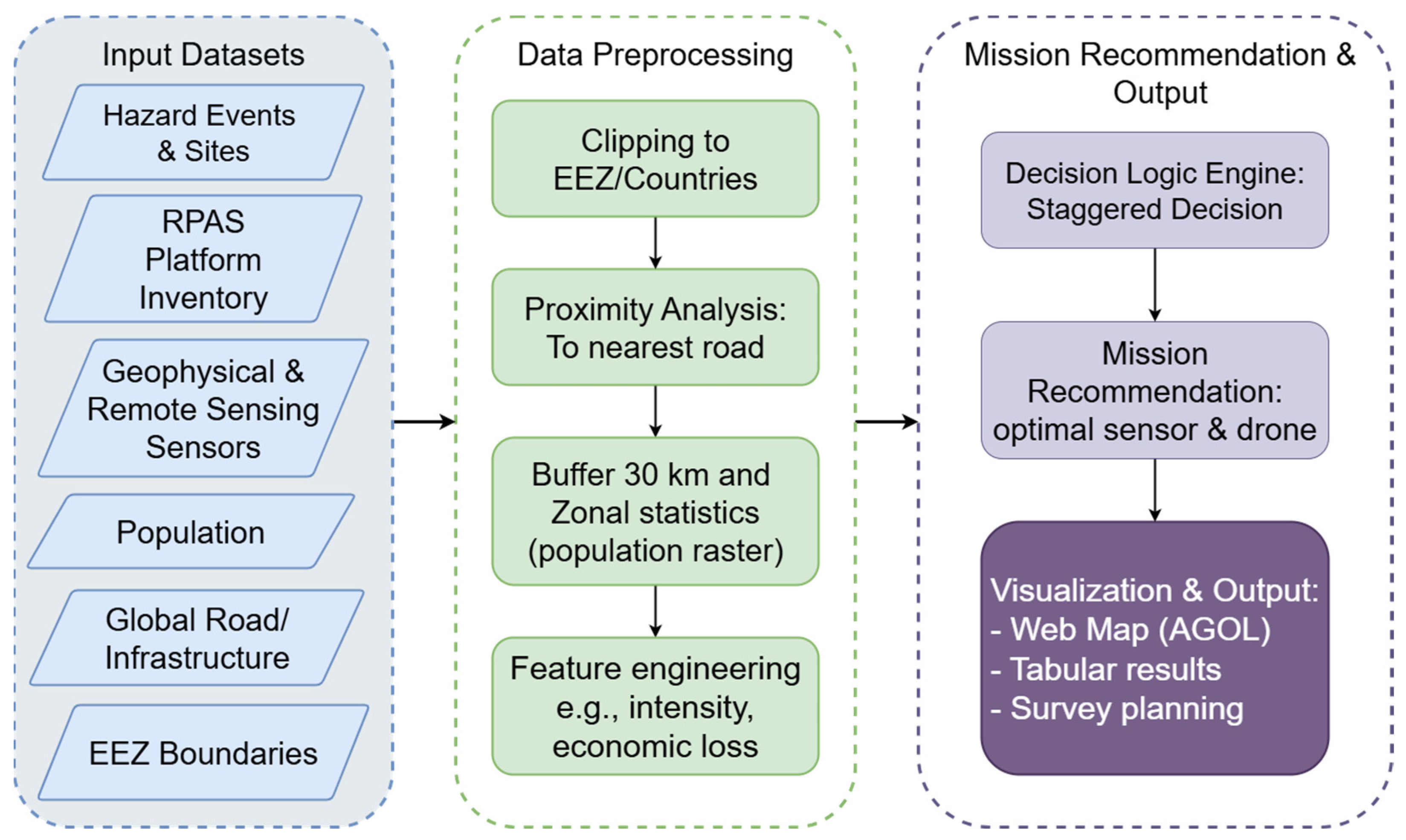
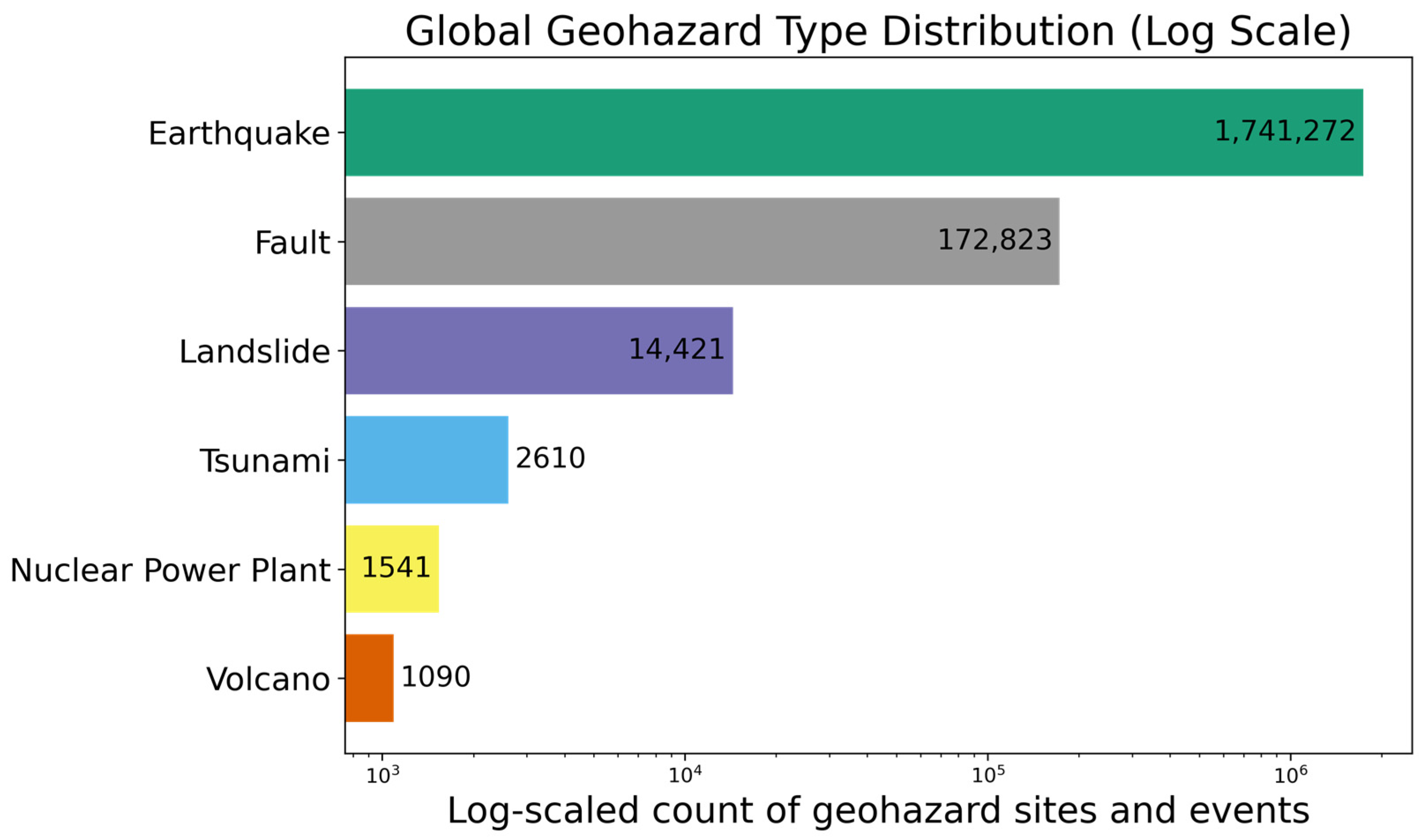
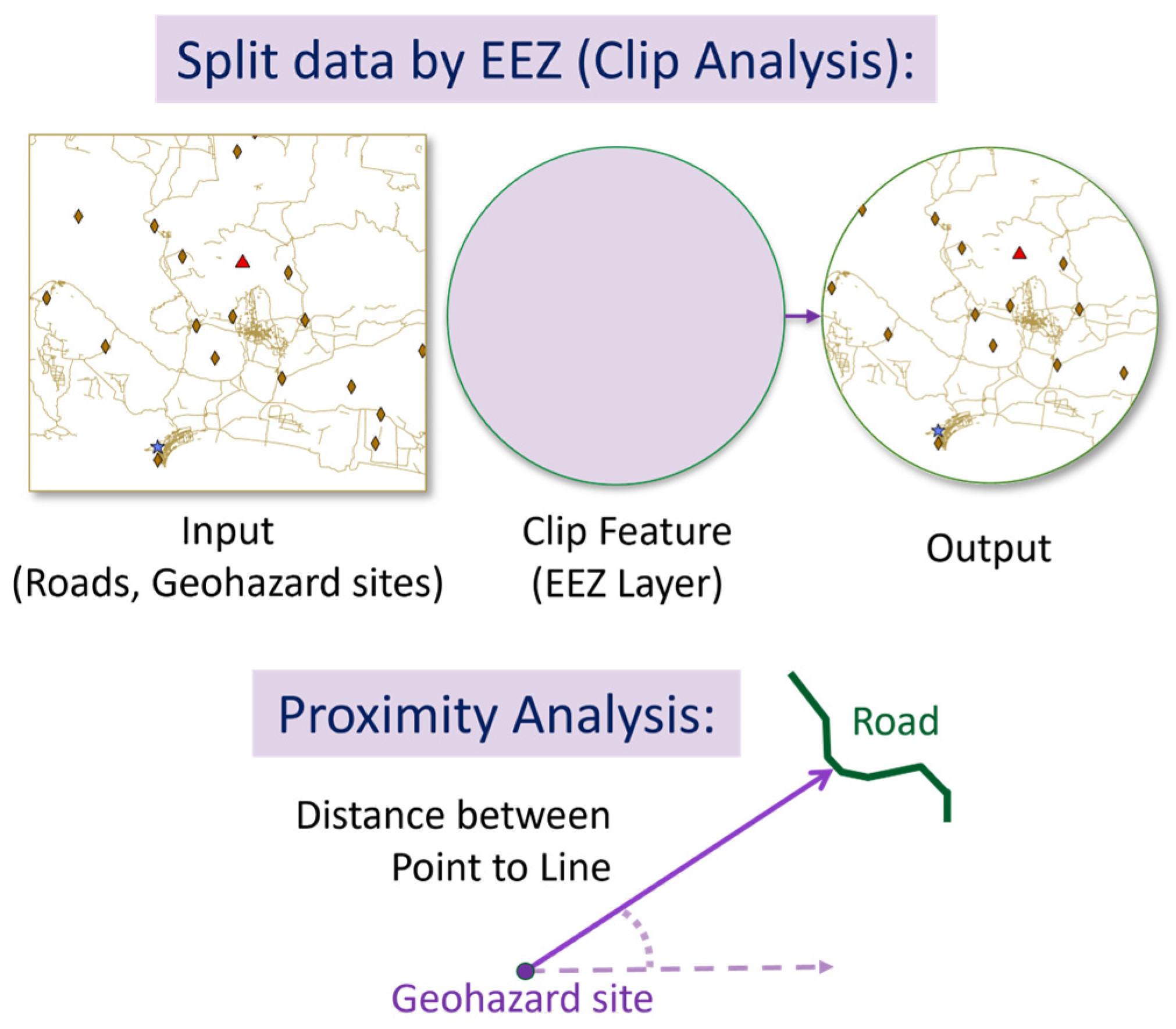

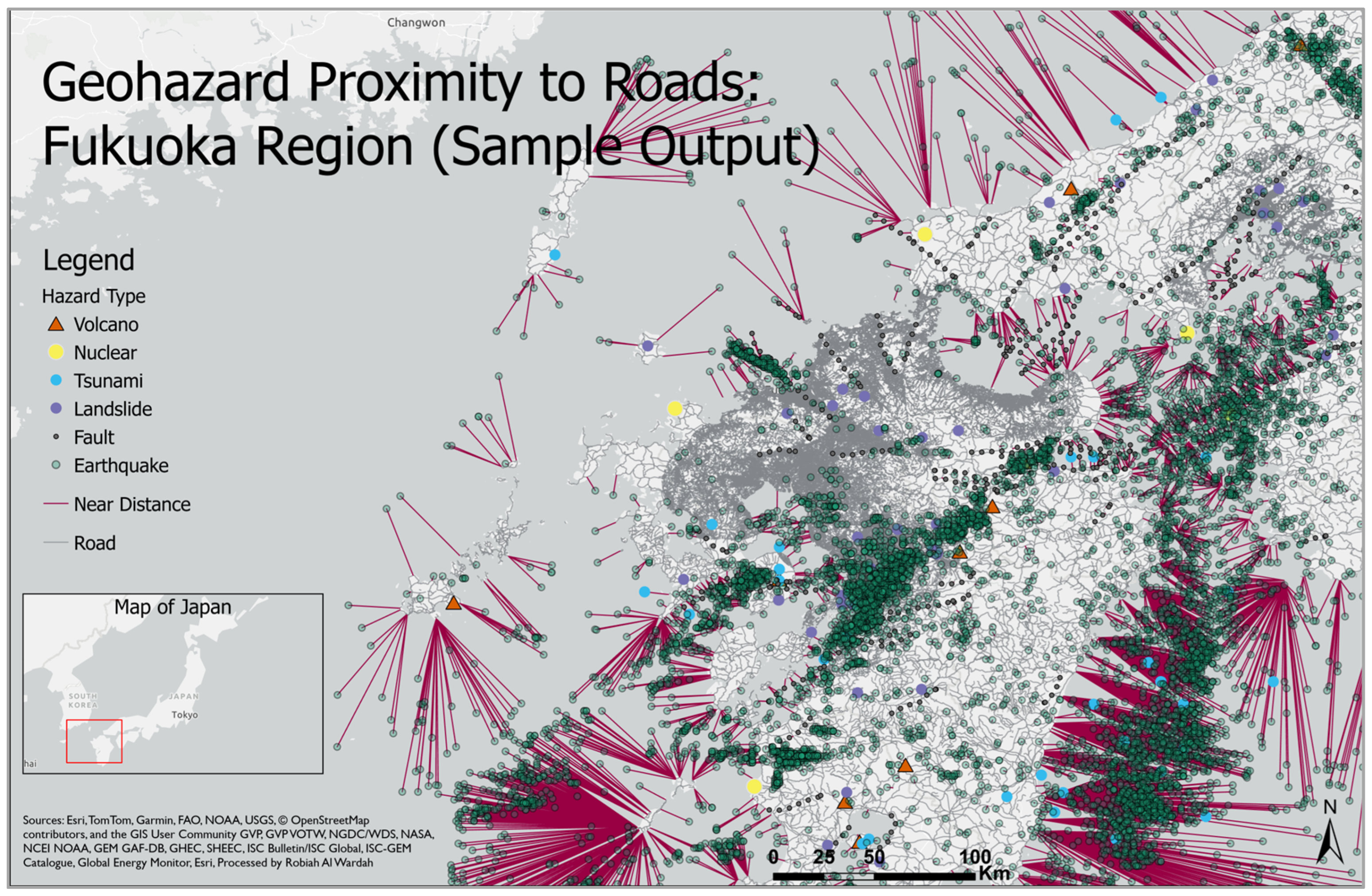
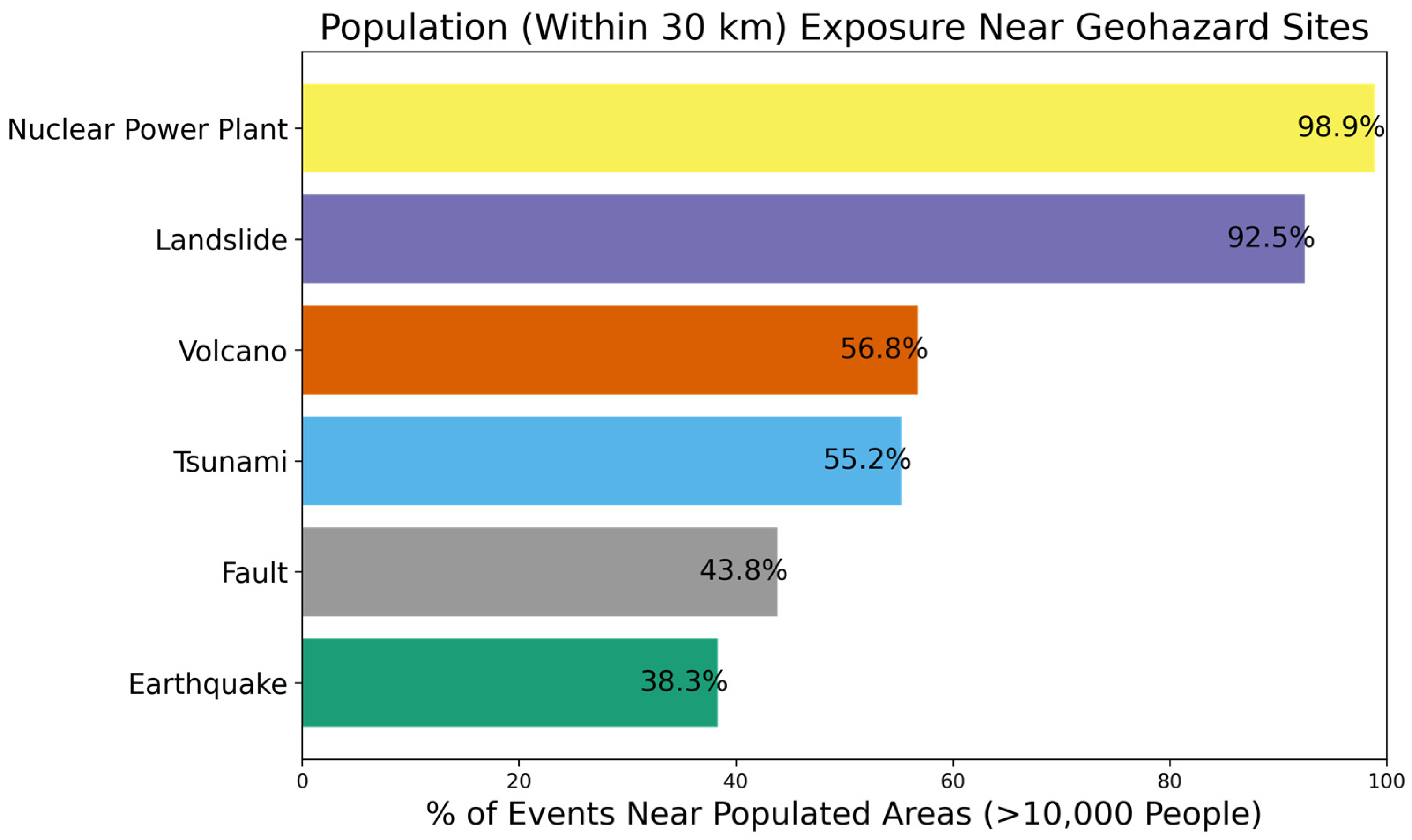
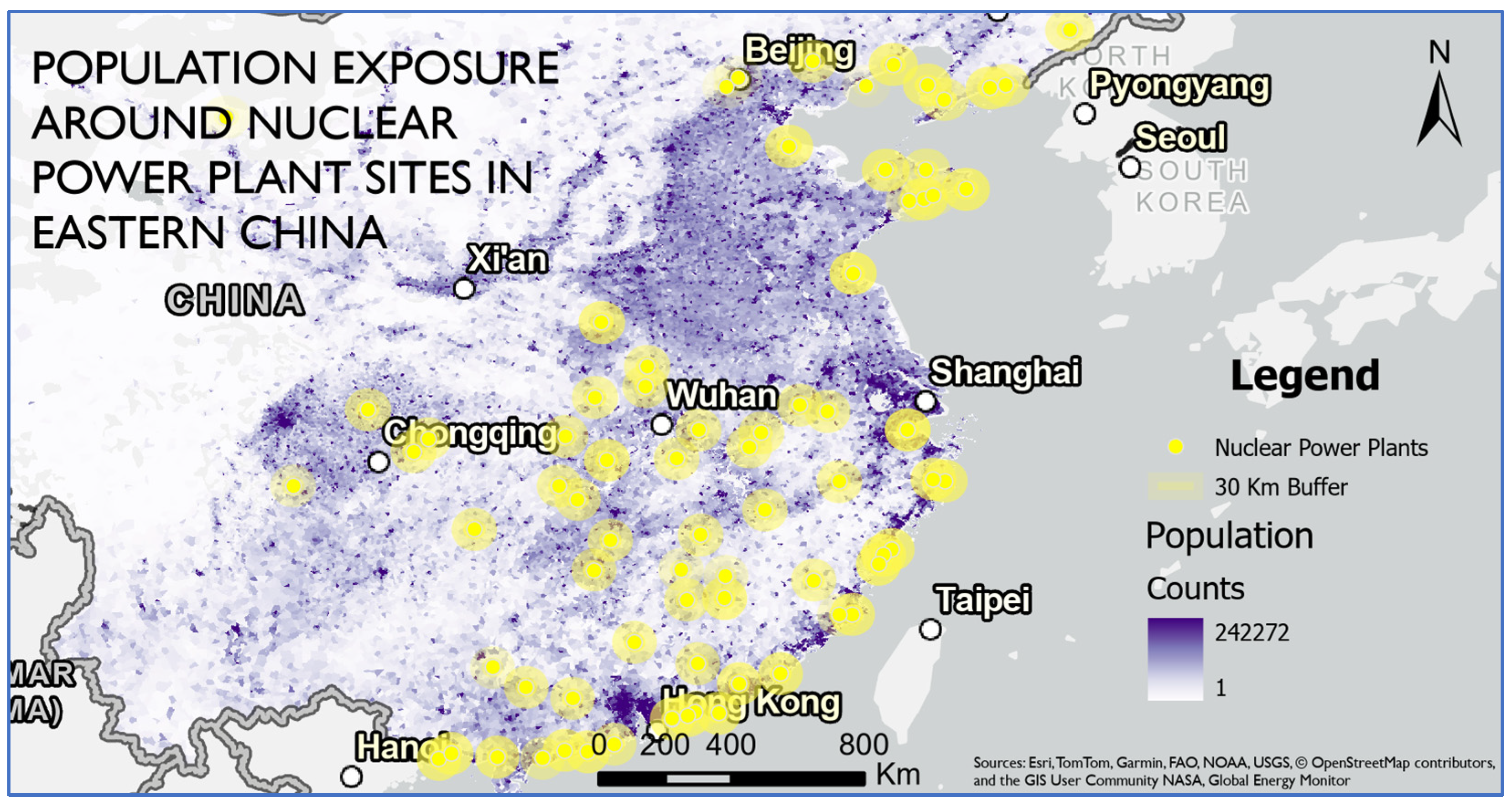
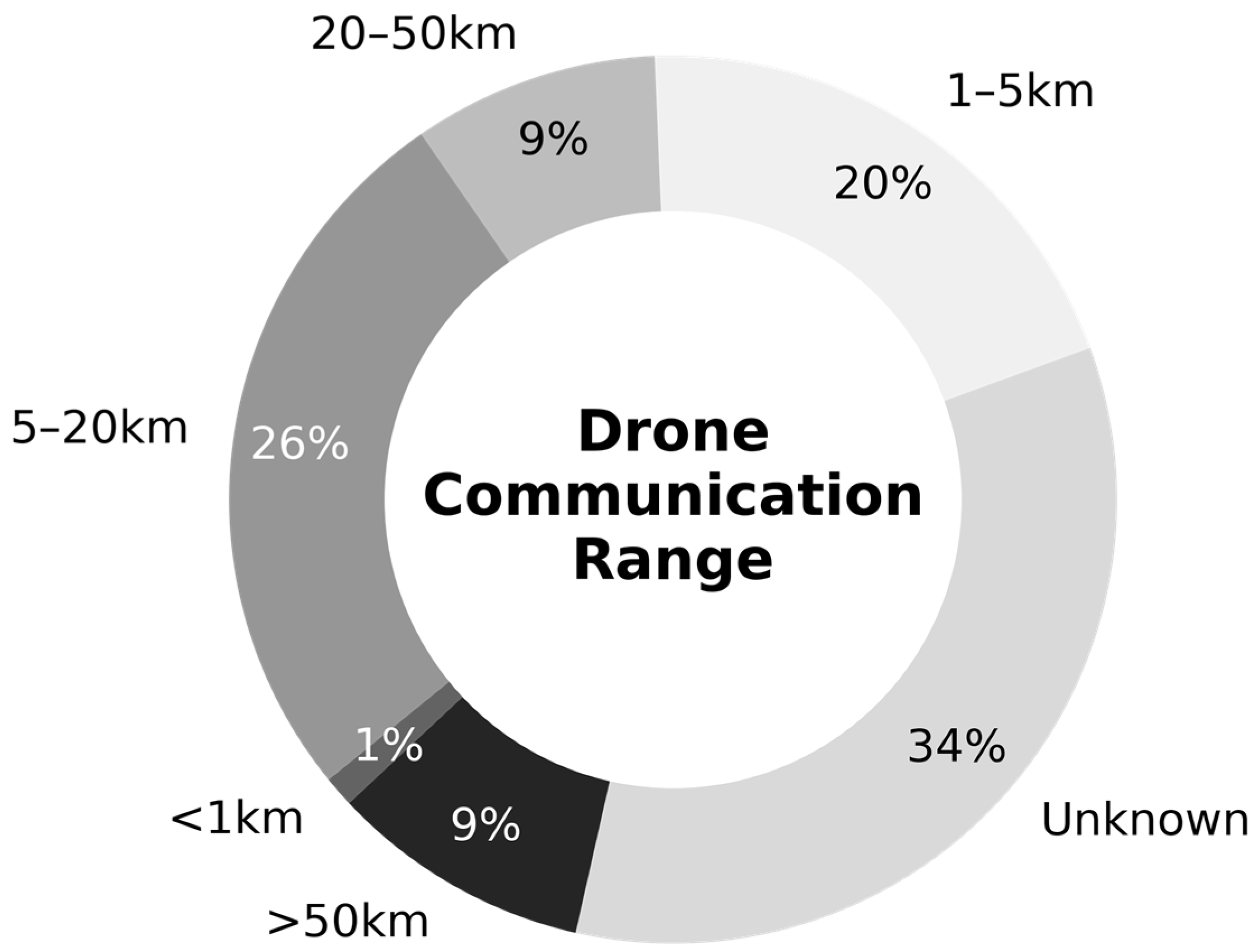
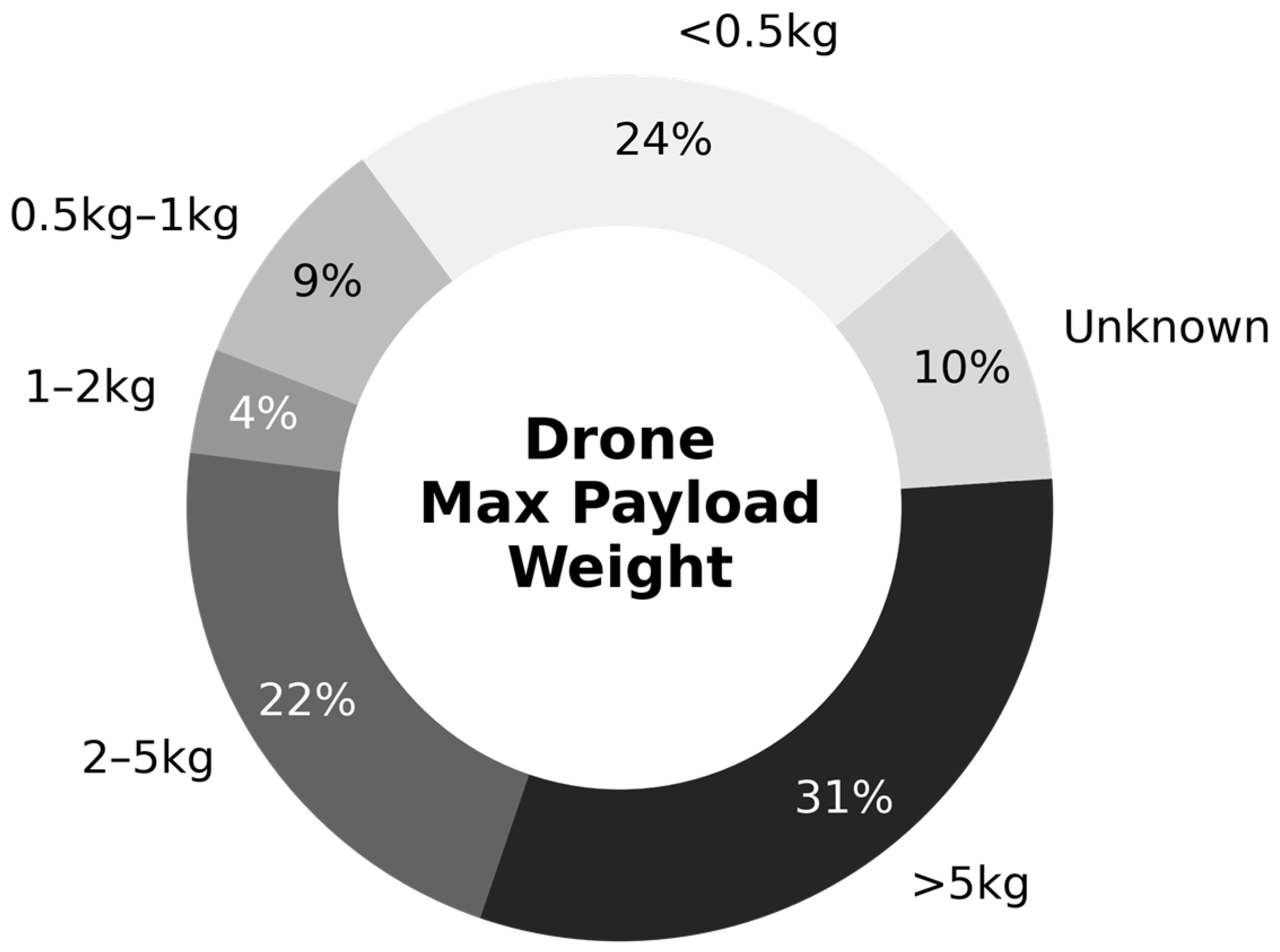
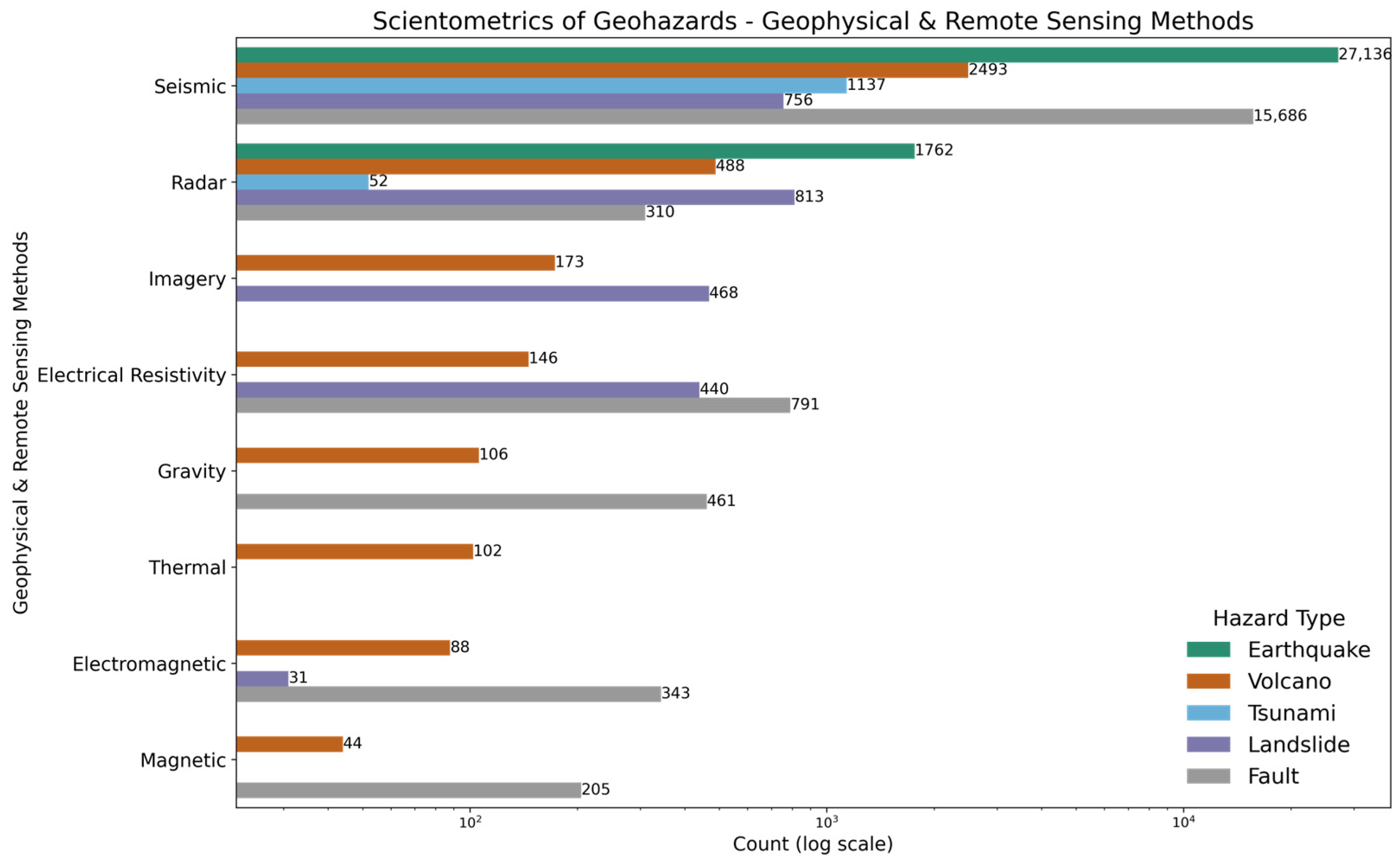
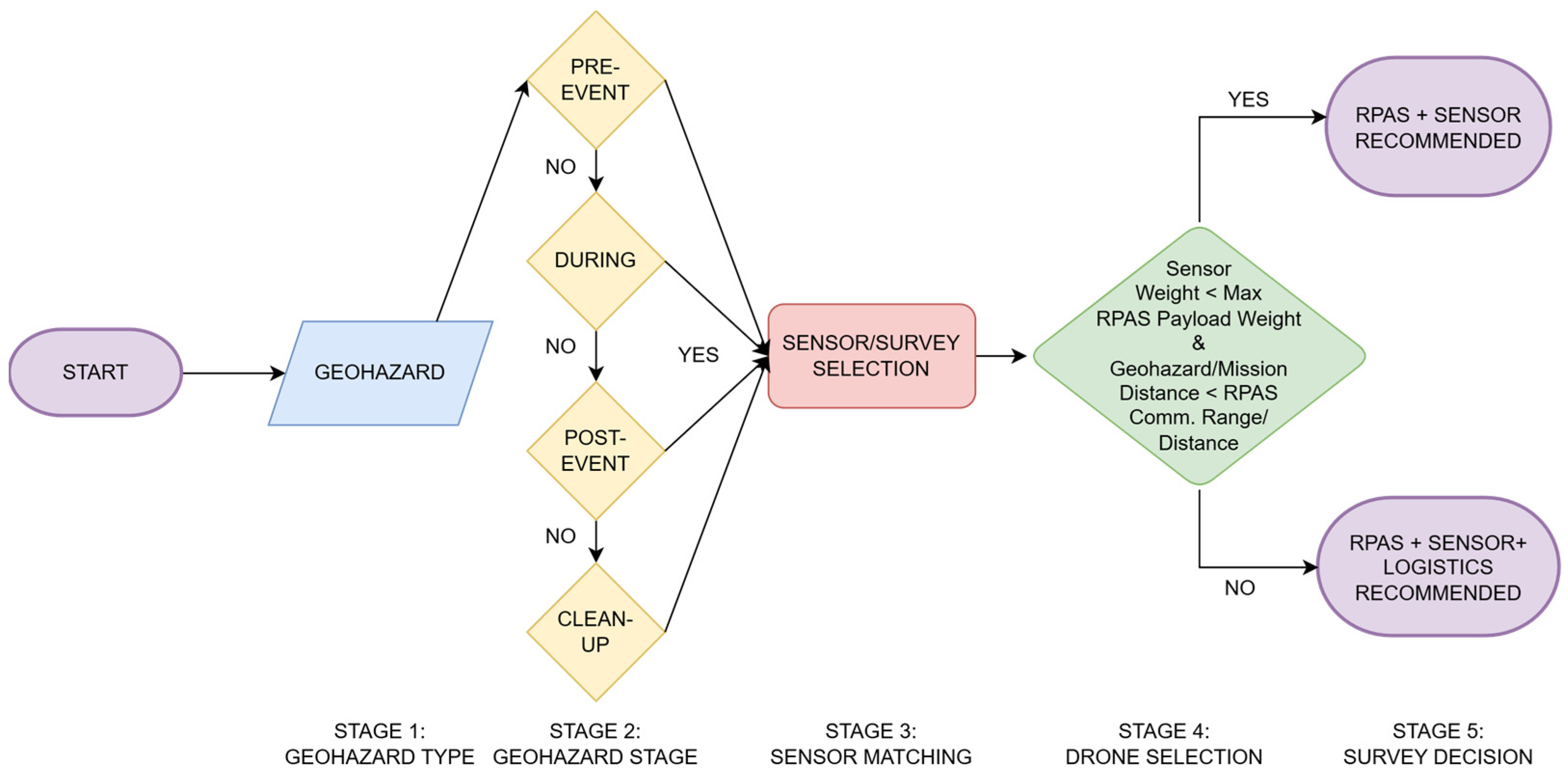
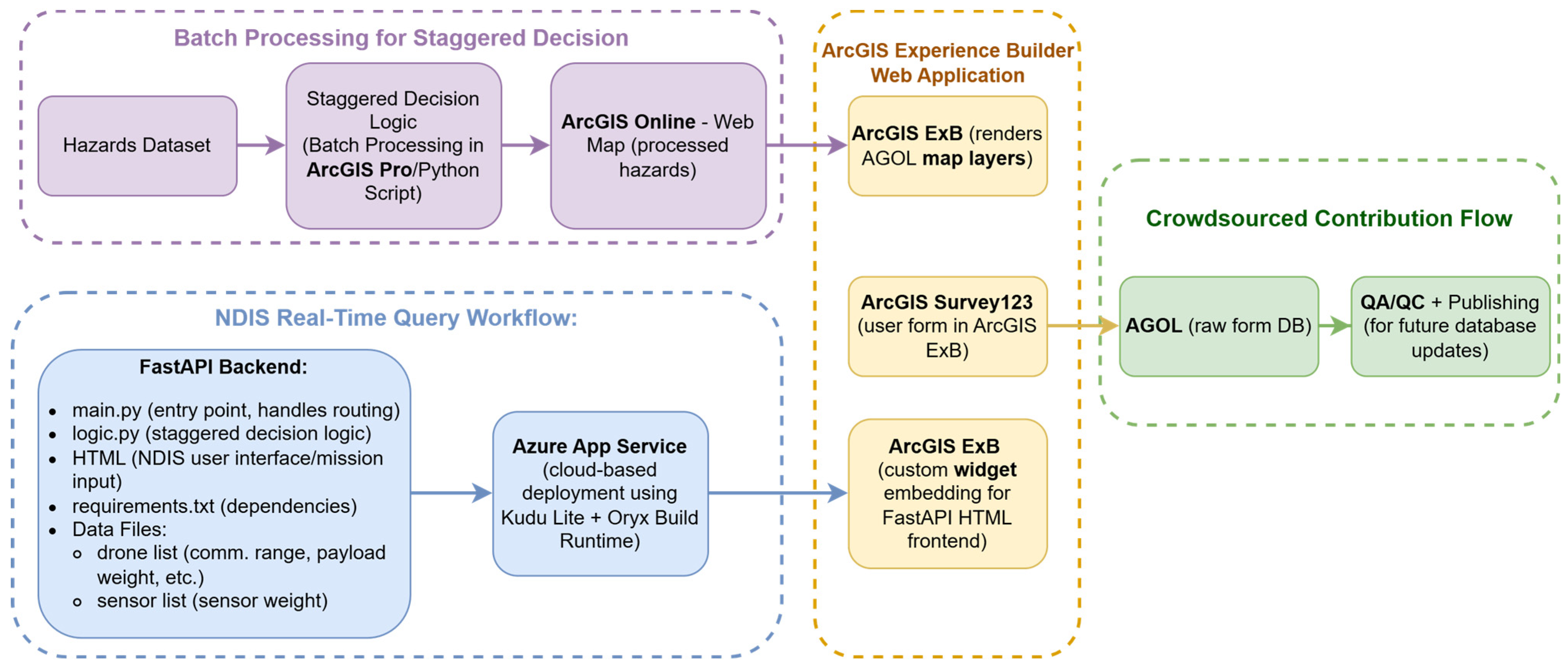
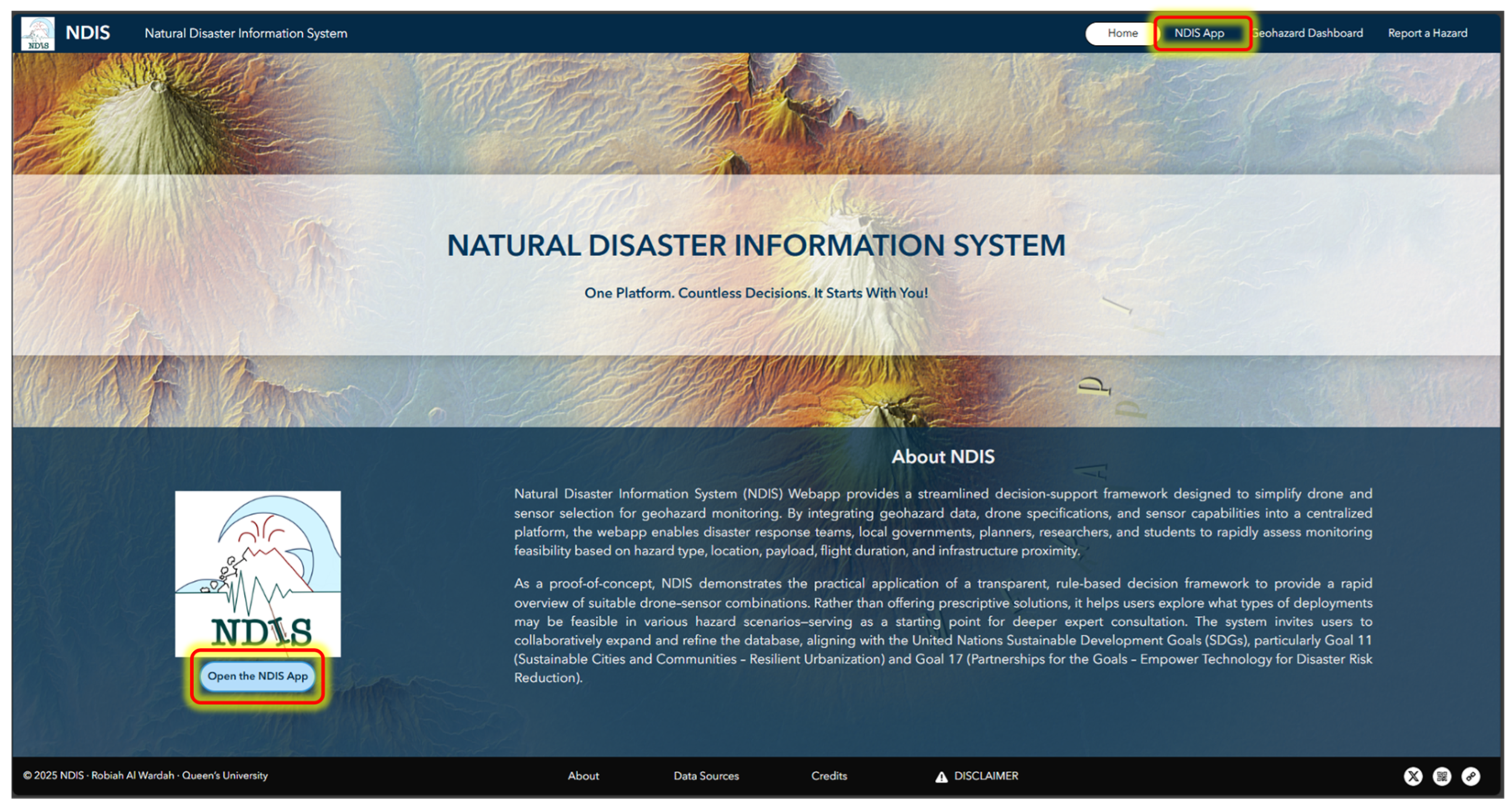
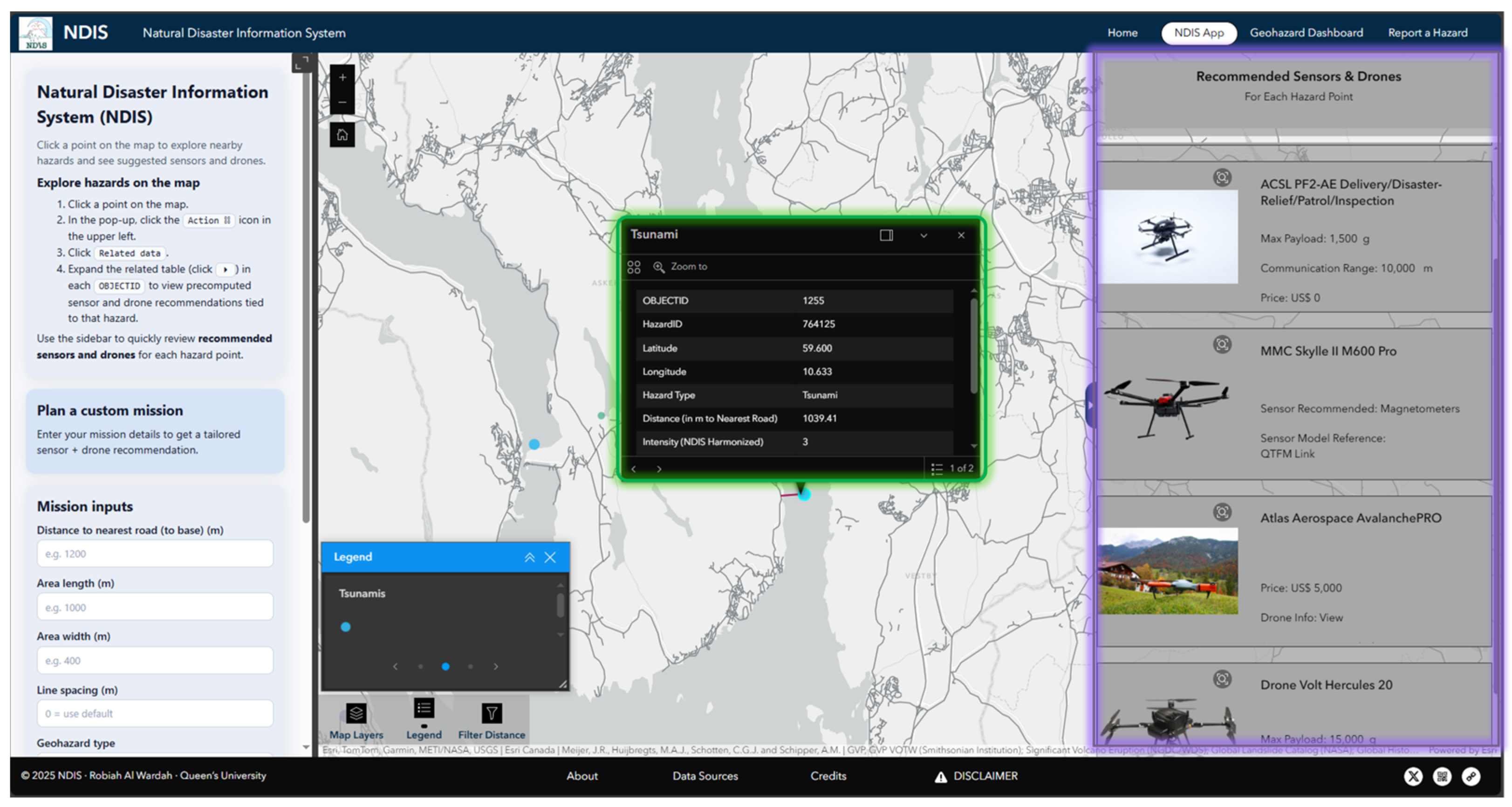
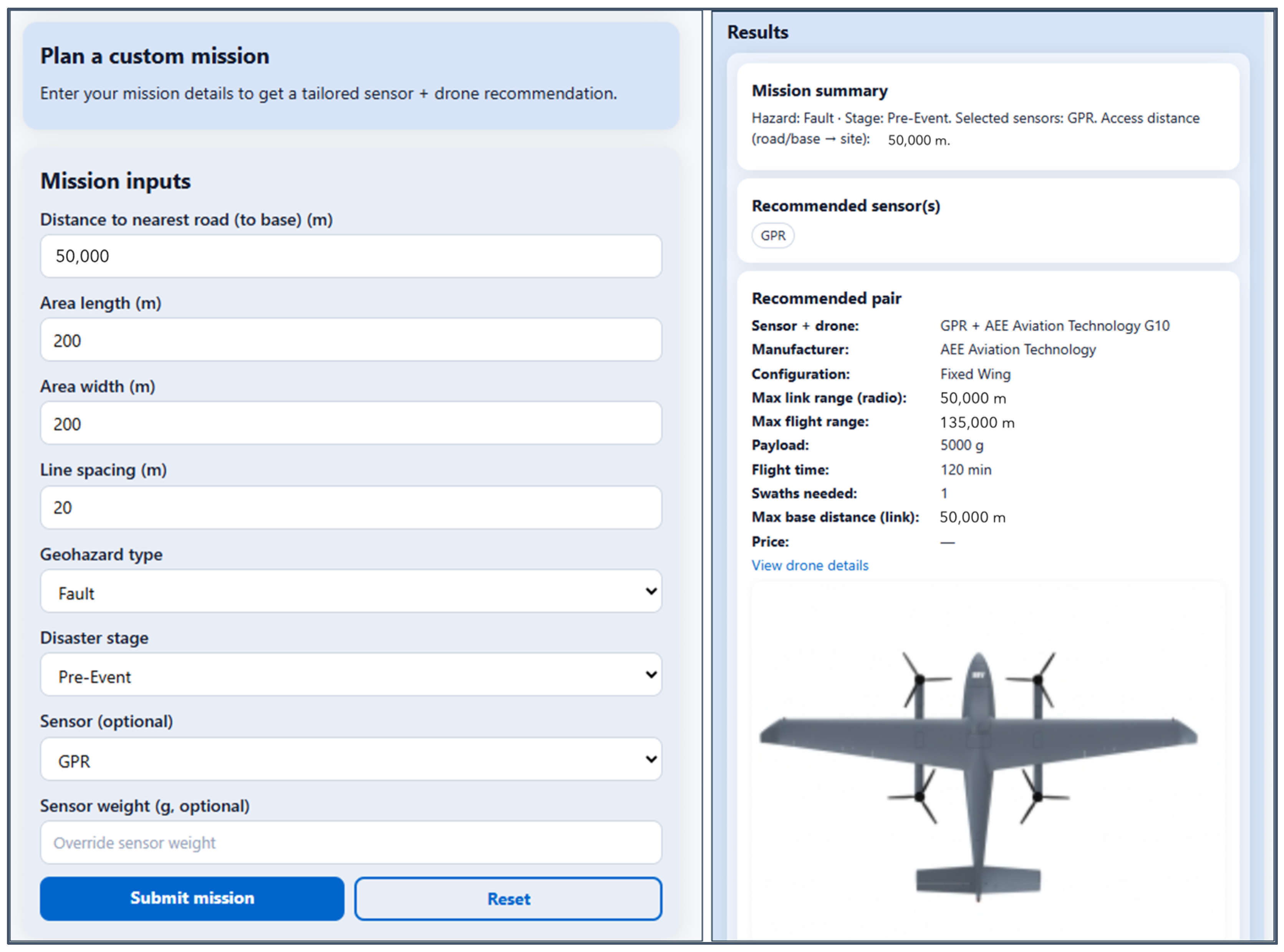
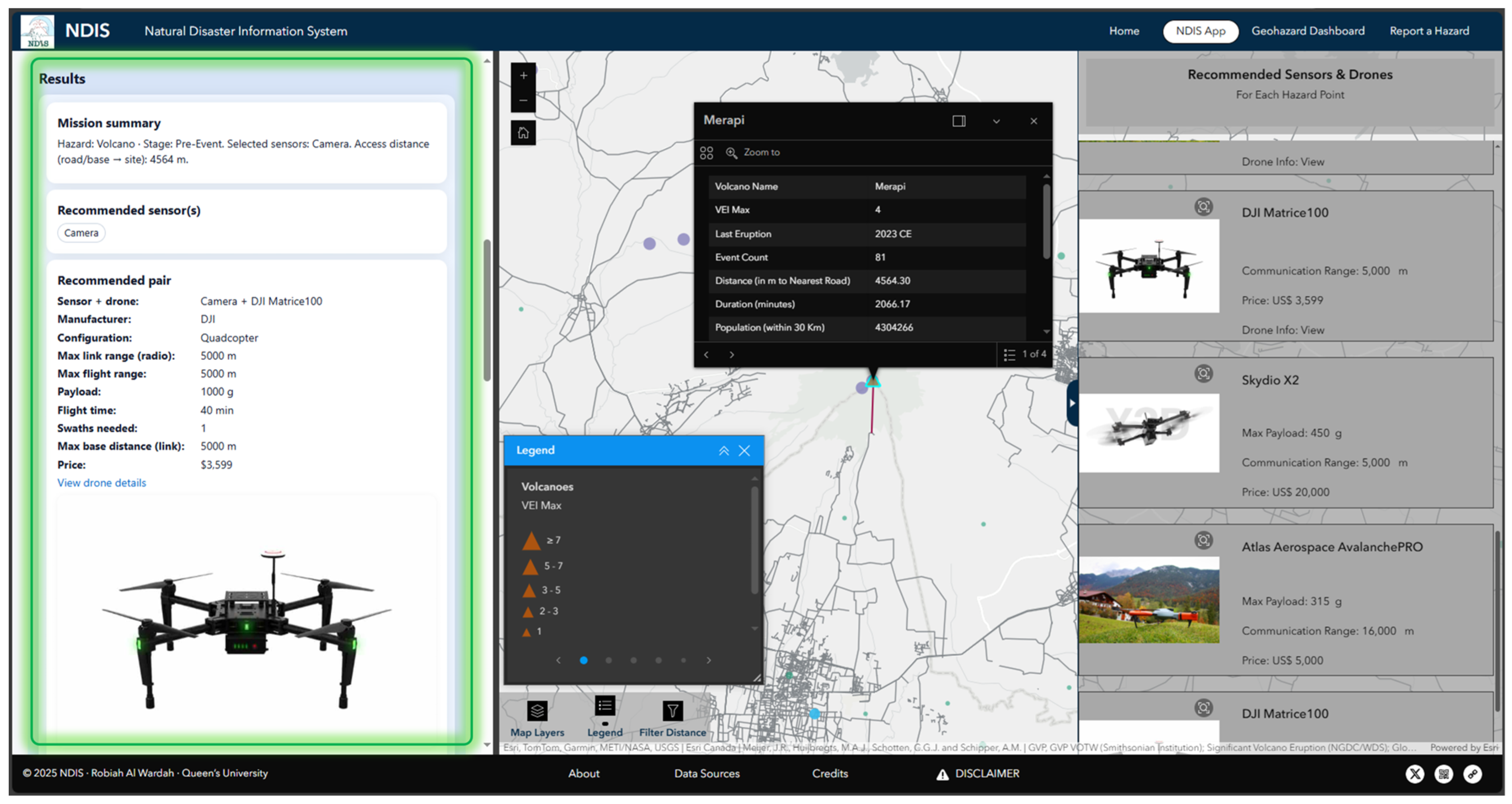
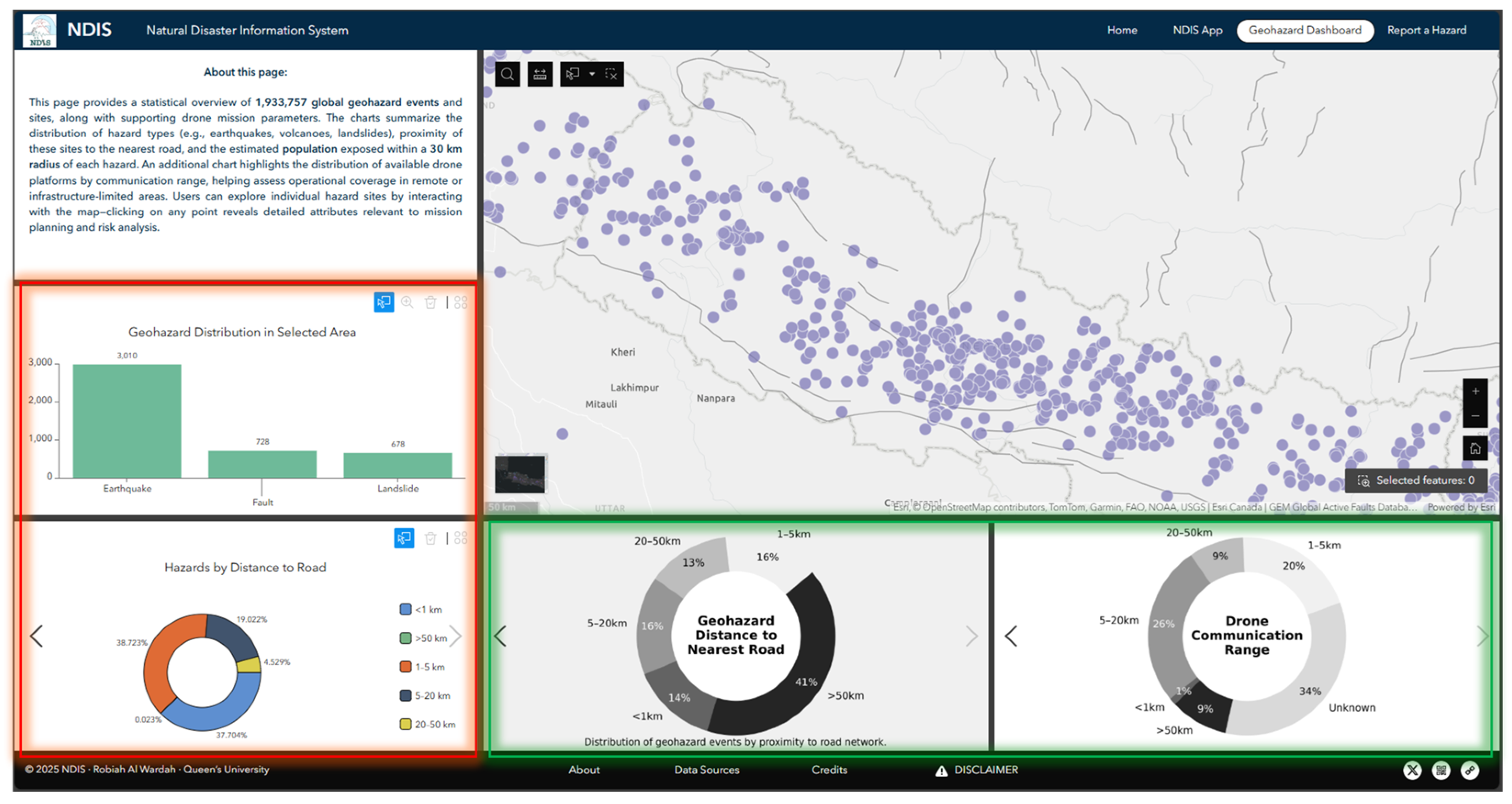
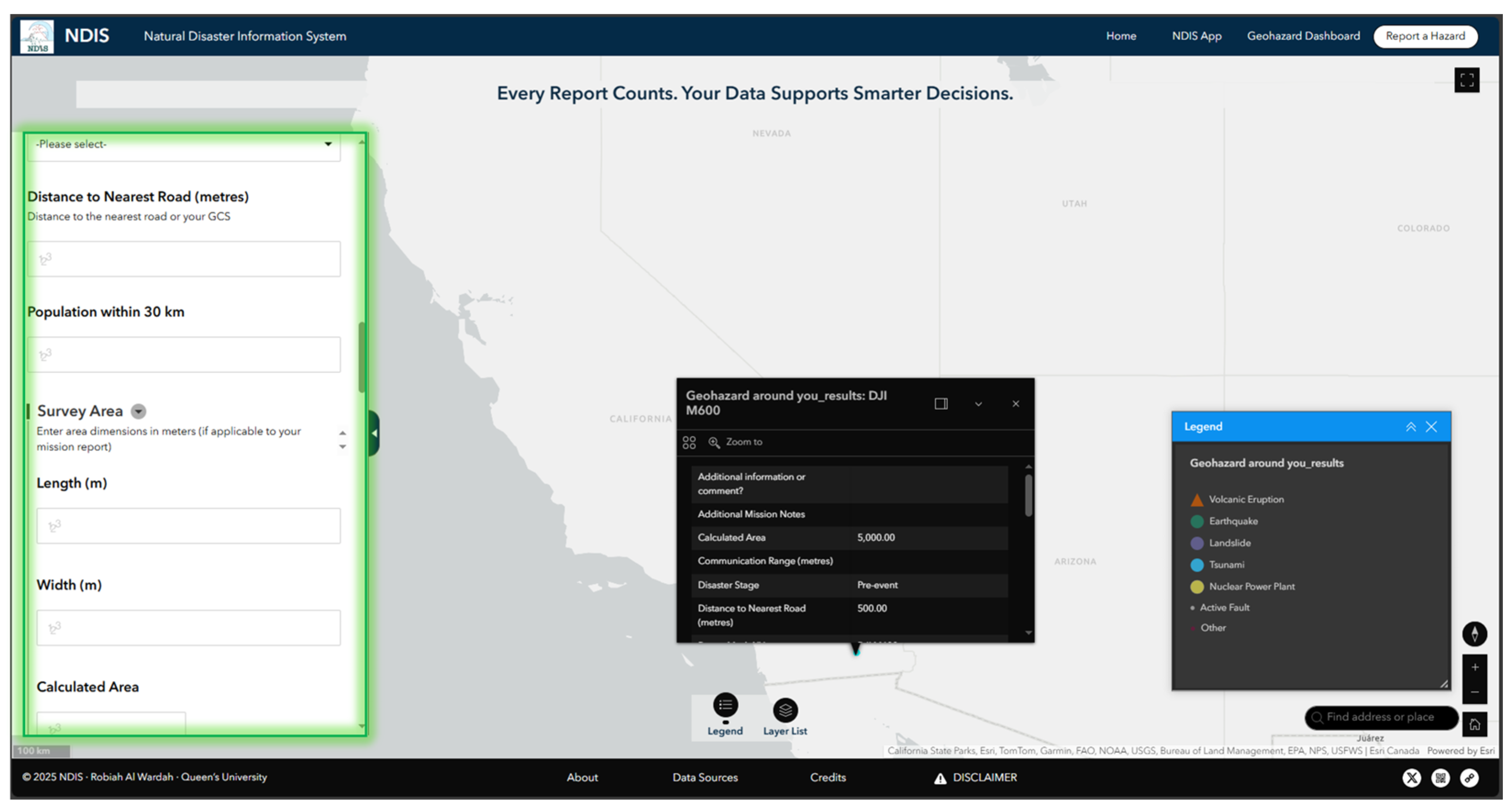

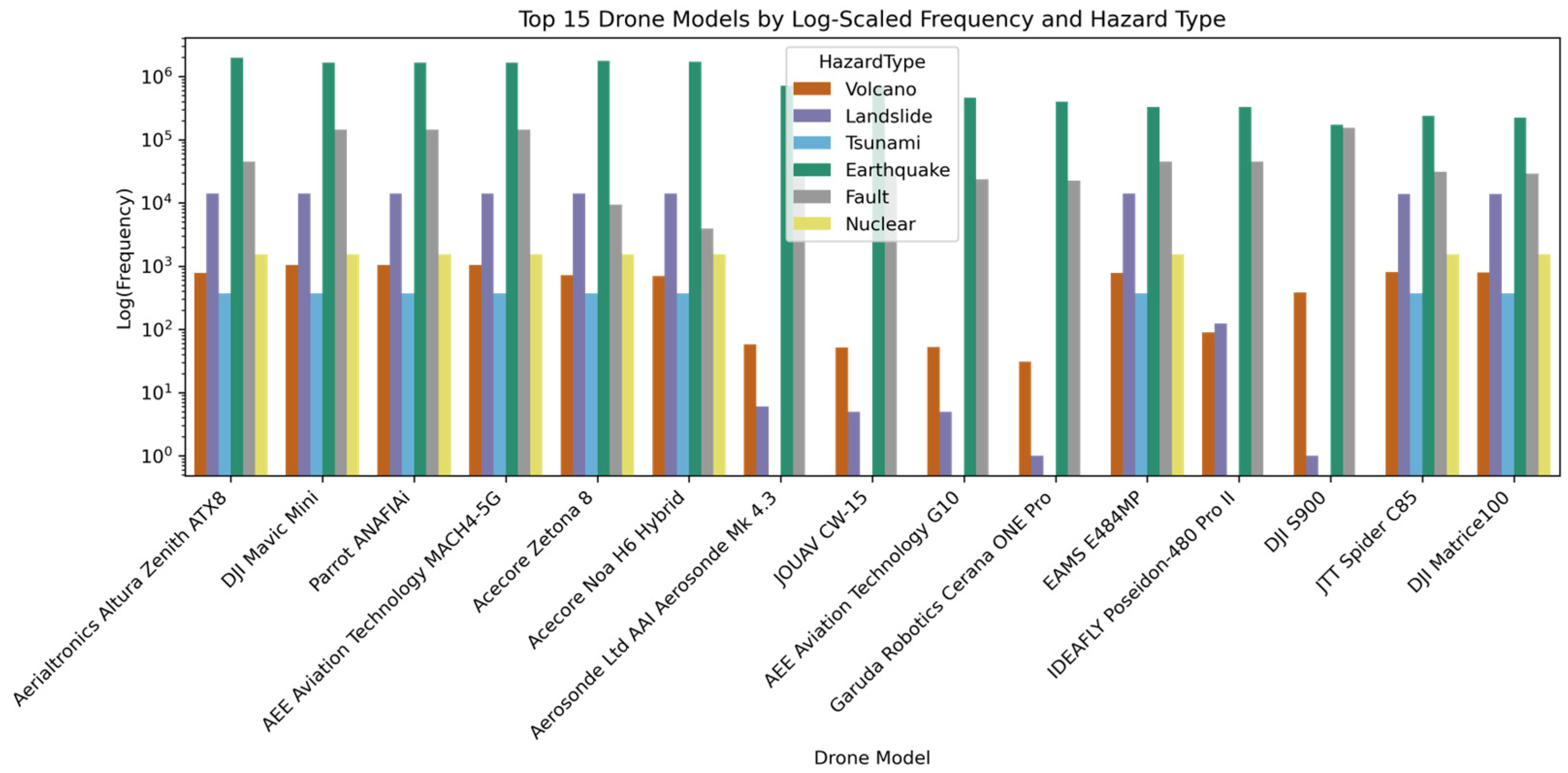
| Mission Type | Mission Distance D | Travel Time | Monitor Time | Setup Buffer | CPM Total Time |
|---|---|---|---|---|---|
| Delivery | 20 min | ||||
| Mapping | or (LiDAR alternative) | 40 min |
| Hazard Type | Intensity | Duration (min) | Economic Loss (in M US$) |
|---|---|---|---|
| Volcanoes | , where See Table A1 for ordinal scale | ||
| Landslides | 0.7⋅S + 0.3⋅C | , based on I | |
| Tsunamis | f(TS_MT_II) or Eq. reference [19]. See Table A2 for ordinal scale | , based on I | |
| Faults | , based on I | ||
| Earthquakes | , based on I | ||
| Nuclear Power Plants |
| Approach | Description | Interpretability | Adaptability | Constraint Handling | Outcome |
|---|---|---|---|---|---|
| (i) Independent DT | Separate trees for sensor & drone | High | Low | Weak | Discarded |
| (ii) Combined DT | Joint tree for sensor–drone | Medium | Low | Moderate | Discarded |
| (iii) RF Classifier | Ensemble classifier | Low | Low | Weak | Discarded |
| (iv) Staggered Decision | Modular logic-based system | High | High | Strong | Selected |
| Hazard Type | Disaster Phase | Recommended Sensors |
|---|---|---|
| Volcano | Pre-Event | Magnetometers, Seismic, Camera |
| Volcano | During | Thermal Camera, Camera, LiDAR |
| Volcano | Post-Event | LiDAR, Camera, Seismic |
| Volcano | Clean-Up | LiDAR, Camera, Seismic |
| Earthquake | Pre-Event | Seismic, Magnetometers, Camera |
| Earthquake | During | Seismic, Camera, LiDAR |
| Earthquake | Post-Event | LiDAR, Camera, Seismic |
| Fault | Pre-Event | Seismic, Magnetometers, Camera |
| Fault | Post-Event | Seismic, Camera, LiDAR |
| Landslide | Pre-Event | LiDAR, GPR, Camera |
| Landslide | During | Camera, Thermal Camera, LiDAR |
| Landslide | Post-Event | LiDAR, Seismic, Camera |
| Landslide | Clean-Up | Camera, LiDAR, Seismic |
| Tsunami | During | BPR, Camera, Seismic |
| Tsunami | Post-Event | BPR, LiDAR, Camera |
| Tsunami | Clean-Up | Camera, LiDAR, Thermal Camera |
| Nuclear | Pre-Event | Thermal Camera, Camera, LiDAR |
| Nuclear | During | Thermal Camera, Camera, LiDAR |
| Nuclear | Post-Event | Camera, LiDAR, Gamma Spectrometer |
| Nuclear | Clean-Up | Camera, LiDAR, Gamma Spectrometer |
| Feature | ShakeMap | PAGER | Copernicus EMS | InaSAFE | NDIS |
|---|---|---|---|---|---|
| Hazard Input | Earthquake only | Earthquake only | Multiple | Multiple | Multiple |
| Data Source | USGS | USGS + Pop. Data | Satellite imagery | Local hazard layers | Global multisource |
| Mission Planning | ✕ | ✕ | ✕ | ✕ | ✓ |
| Sensor Matching | ✕ | ✕ | ✕ | ✕ | ✓ |
| Drone Matching | ✕ | ✕ | ✕ | ✕ | ✓ |
| Output Type | Maps, Alerts | Casualty Estimates | Thematic Maps | Impact Summary | Drone-Sensor Pair+CPM |
Disclaimer/Publisher’s Note: The statements, opinions and data contained in all publications are solely those of the individual author(s) and contributor(s) and not of MDPI and/or the editor(s). MDPI and/or the editor(s) disclaim responsibility for any injury to people or property resulting from any ideas, methods, instructions or products referred to in the content. |
© 2025 by the authors. Licensee MDPI, Basel, Switzerland. This article is an open access article distributed under the terms and conditions of the Creative Commons Attribution (CC BY) license (https://creativecommons.org/licenses/by/4.0/).
Share and Cite
Al Wardah, R.; Braun, A. Natural Disaster Information System (NDIS) for RPAS Mission Planning. Drones 2025, 9, 734. https://doi.org/10.3390/drones9110734
Al Wardah R, Braun A. Natural Disaster Information System (NDIS) for RPAS Mission Planning. Drones. 2025; 9(11):734. https://doi.org/10.3390/drones9110734
Chicago/Turabian StyleAl Wardah, Robiah, and Alexander Braun. 2025. "Natural Disaster Information System (NDIS) for RPAS Mission Planning" Drones 9, no. 11: 734. https://doi.org/10.3390/drones9110734
APA StyleAl Wardah, R., & Braun, A. (2025). Natural Disaster Information System (NDIS) for RPAS Mission Planning. Drones, 9(11), 734. https://doi.org/10.3390/drones9110734







